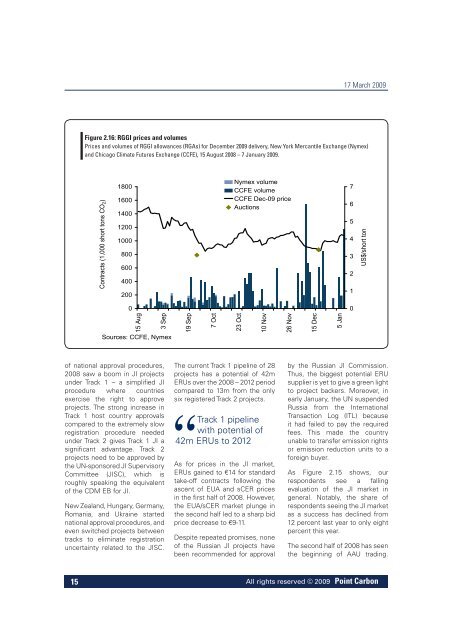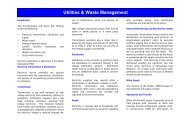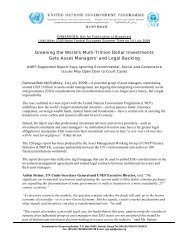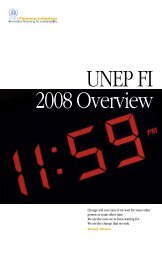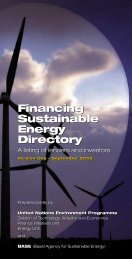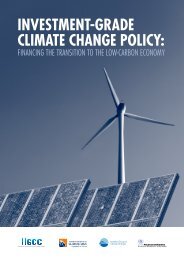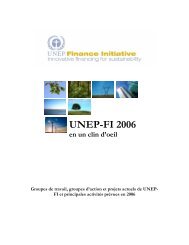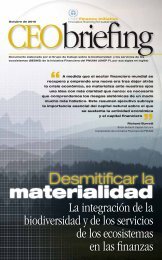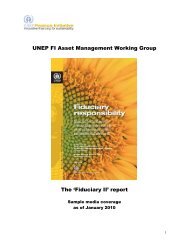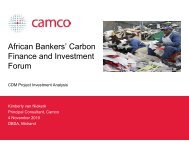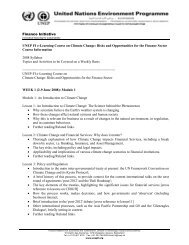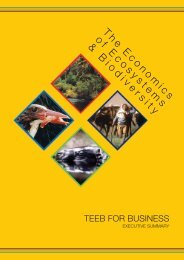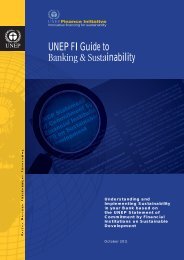Carbon 2009 Emission trading coming home - UNEP Finance Initiative
Carbon 2009 Emission trading coming home - UNEP Finance Initiative
Carbon 2009 Emission trading coming home - UNEP Finance Initiative
Create successful ePaper yourself
Turn your PDF publications into a flip-book with our unique Google optimized e-Paper software.
17 March <strong>2009</strong><br />
Figure 2.16: RGGI prices and volumes<br />
Prices and volumes of RGGI allowances (RGAs) for December <strong>2009</strong> delivery, New York Mercantile Exchange (Nymex)<br />
and Chicago Climate Futures Exchange (CCFE), 15 August 2008 – 7 January <strong>2009</strong>.<br />
Contracts (1,000 short tons CO 2 )<br />
1800<br />
1600<br />
1400<br />
1200<br />
1000<br />
800<br />
600<br />
400<br />
200<br />
Nymex volume<br />
CCFE volume<br />
CCFE Dec-09 price<br />
Auctions<br />
7<br />
6<br />
5<br />
4<br />
3<br />
2<br />
1<br />
US$/short ton<br />
0<br />
0<br />
15 Aug<br />
3 Sep<br />
Sources: CCFE, Nymex<br />
19 Sep<br />
7 Oct<br />
23 Oct<br />
10 Nov<br />
26 Nov<br />
15 Dec<br />
5 Jan<br />
of national approval procedures,<br />
2008 saw a boom in JI projects<br />
under Track 1 – a simplified JI<br />
procedure where countries<br />
exercise the right to approve<br />
projects. The strong increase in<br />
Track 1 host country approvals<br />
compared to the extremely slow<br />
registration procedure needed<br />
under Track 2 gives Track 1 JI a<br />
significant advantage. Track 2<br />
projects need to be approved by<br />
the UN-sponsored JI Supervisory<br />
Committee (JISC), which is<br />
roughly speaking the equivalent<br />
of the CDM EB for JI.<br />
New Zealand, Hungary, Germany,<br />
Romania, and Ukraine started<br />
national approval procedures, and<br />
even switched projects between<br />
tracks to eliminate registration<br />
uncertainty related to the JISC.<br />
The current Track 1 pipeline of 28<br />
projects has a potential of 42m<br />
ERUs over the 2008 – 2012 period<br />
compared to 13m from the only<br />
six registered Track 2 projects.<br />
Track 1 pipeline<br />
with potential of<br />
42m ERUs to 2012<br />
As for prices in the JI market,<br />
ERUs gained to €14 for standard<br />
take-off contracts following the<br />
ascent of EUA and sCER prices<br />
in the first half of 2008. However,<br />
the EUA/sCER market plunge in<br />
the second half led to a sharp bid<br />
price decrease to €9-11.<br />
Despite repeated promises, none<br />
of the Russian JI projects have<br />
been recommended for approval<br />
by the Russian JI Commission.<br />
Thus, the biggest potential ERU<br />
supplier is yet to give a green light<br />
to project backers. Moreover, in<br />
early January, the UN suspended<br />
Russia from the International<br />
Transaction Log (ITL) because<br />
it had failed to pay the required<br />
fees. This made the country<br />
unable to transfer emission rights<br />
or emission reduction units to a<br />
foreign buyer.<br />
As Figure 2.15 shows, our<br />
respondents see a falling<br />
evaluation of the JI market in<br />
general. Notably, the share of<br />
respondents seeing the JI market<br />
as a success has declined from<br />
12 percent last year to only eight<br />
percent this year.<br />
The second half of 2008 has seen<br />
the beginning of AAU <strong>trading</strong>.<br />
15<br />
All rights reserved © <strong>2009</strong> Point <strong>Carbon</strong>


